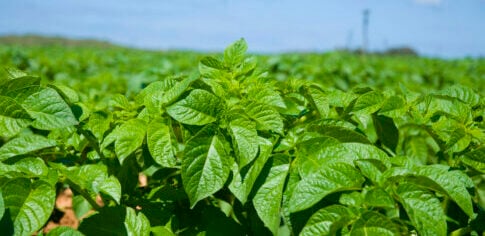आलू के खेती के लिए खाद की विशेषता | Aloo ke kheti ke liye khad
आलू के उर्वरीकरण, सर्वोत्तम तरीके, उपयुक्त प्रोडक्ट्स, ज़मीनी परीक्षण और बहुत कुछ जो आपको जानने की आवश्यकता है।
आलू (सोलनम ट्यूबरोसम) उगाने के लिए सुझाव
-
आलू की फसल 5.5 और 6.7 के बीच pH वाली मिट्टी में सबसे अच्छा प्रदर्शन करती है।
-
आलू को अच्छी तरह से पनपने और उपज देने के लिए रेतीली दोमट से लेकर सिल्ट वाली दोमट मिट्टी चाहिए जो जैविक रूप से समृद्ध हो और जिसमें अच्छी जल निकासी होती हो। ऐसी ज़मीन उत्तर प्रदेश और पश्चिम बंगाल के गंगा के मैदानों में पाई जाती है।
-
उच्च पीएच (7.5 से ऊपर) वाली मिट्टी में, मुख्य रूप से तो फास्फोरस, लेकिन अन्य सूक्ष्म पोषक तत्वों की भी, कमी दिखाई दे सकती है।
-
उच्च पीएच स्थितियों में, आलू में स्ट्रेप्टोमीस स्केबीज के कारण होने वाले स्कैब बैक्टीरियल संक्रमण की आशंका बनी रहती है।
-
15 से 20°C के तापमान वाली अच्छी जल निकासी वाली, हवादार मिट्टी, जड़ों के विकास और कंद की शुरुआत के लिए बेहतर साबित होती हैं।
-
छोटे दिनो में आलू कंद की उपज की शुरुआत अच्छी होती है। जबकि लम्बे दिनों में इसमें देरी होगी।

आलू के पौधे की स्वस्थ पत्तियां

अनुकूल स्थिति में की गई आलू की कटाई
पोषक तत्वों की आवश्यकताएँ
अनुमानित पोषक तत्व (kg/t):
| N | P2O5 | K2O | MgO | SO3 | CaO | |
|---|---|---|---|---|---|---|
| किलो/ हेक्टेयर | किलो/ हेक्टेयर | किलो/ हेक्टेयर | किलो/ हेक्टेयर | किलो/ हेक्टेयर | किलो/ हेक्टेयर | |
| कंद | 3 | 1.5 | 6.5 | 0.4 | 0.7 | 0.5 |
| भूमि के ऊपर जैविक तत्व | 1.9 | 0.6 | 5.3 | 0.2 | 0.4 | 0.25 |
स्रोत: आईपीएनआई
पोषक तत्वों की भूमिका
| मुख्य पैरामीटर | N | P2O5 | K2O | MgO | CaO | SO3 |
|---|---|---|---|---|---|---|
| उपज | ++ | + | ++ | + | +/- | +/- |
| कंद का आकार | ++ | ++ | + | |||
| कंद वजन | ++ | + | ++ | |||
| त्वचा का सेट | - | + | + | |||
| खरोंच और संभालना | - | + | ++ | ++ | ||
| कंद का रंग (आंतरिक काला पड़ना) | +/- | + | ||||
| शुष्क पदार्थ सामग्री | - | +/- | - | +/- | ||
| स्टार्च सामग्री | - | + | +/- |
+ = सुधार
– = घट रहा है
+/- = विभिन्न परिणाम, पोषक तत्वों की दर के आधार पर
स्रोत: आईपीआई बुलेटिन – उच्च उपज के लिए उर्वरक | आलू
पोषक तत्वों की कमी
| Nutrient | Description | |
|---|---|---|
| Nitrogen | Leaves are pale green (general chlorosis). Old leaves remain yellow, while younger leaves turn darker. Plants will produce fewer stems and tubers. |
|
| Phosphorous | Plant growth is stunted. Darker colour than normal. The lower leaf surface is a grey-green colour. Leaflets roll upwards if deficiency is severe. It occurs on calcareous and heavy soils, where P can be fixed. |
|
| Potassium | Potassium deficiency symptoms normally include a scorched appearance with black pigmentation and necrotic edges (dead tissues). Symptoms appear on the young, full-sized leaves. Common in light soils due to easier leaching. |
|
| Calcium | Moderate calcium deficiency may not appear but in severe situations, the leaf margins can be affected. Brown blotches may appear around the stolon end of the tubers. Tubers may show severe skin cracking. Deficiencies are severe in soils with a pH below 5. |
|
| Magnesium | Chlorosis of leaf margins of older leaves. Yellowing Symptoms appear first on the older leaves, due to magnesium's mobility. General chlorosis with veins remaining green. Scorched appearance caused by interveinal necrosis. Can occur on sandy soils and if high K levels are applied. |
|
| Sulphur | Symptoms are similar to nitrogen deficiency, but deficiency symptoms occur first in younger leaves (as yellowing). General chlorosis. The yellowing is uniform and general. It may occur on loamy, sandy soils. |


